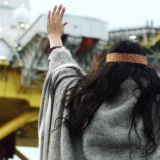
From Our Eyes Engagements with the Escalette Collection
January 12, 2022
The Escalette Collection is looking back at some of the amazing work students created in the Fall 2021 semester based on artwork in the collection. Displaying artwork throughout Chapman’s campus gives students the opportunity to engage with the collection, whether in their classes or just walking by. By bringing their unique backgrounds, perspectives, and knowledge to an artwork, the students and broader Chapman family work together to learn, shape, and redefine the collection in important ways.
Henry Littleworth (Graphic Design, ‘23), shared his experience in Dr. Wendy Salmond’s Art History 335: Theories of Modernism class, which incorporated the Escalette Collection into several projects throughout the semester.
Art History 335: Theories of Modernism examined the intricacies and foundations of the art world as it developed through the 20th Century into the fruition of the 21st. Though weekly class assignments aired on the side of classic academia—consisting of reading, writing and participating in discussions—this class featured two projects that were much more creative and focused on the Escalette Permanent Collection of Art. The first creative project was to record a short audio for the Escalette’s “Panther Perspectives,” a project which uses the reflections of Chapman students, faculty, and staff to create a QR code audio tour of the artwork on campus. For this project, each student first selected an artwork from the collection, then recorded their perspectives on the work, either academic or personal.
Listen to Henry’s Panther Perspective here.
For our final project, my class was given the opportunity to choose between two options: curate a multi-artist exhibition including a work from the Collection, or make an artwork using a work in the Collection. Due to the personalization of the project, my classmates and I were able to explore Chapman’s Escalette Collection in the context of our own personal interests. For example, option one provided students with the platform to construct virtual exhibitions. Some of the students who chose this option created exhibitions whose themes explored feminine and queer identities. The second option provided students with the opportunity to employ their own creative skills and create unique multi-media artworks. When watching the presentations of each project in class, it was fascinating to see how individualized each project had become, and how important and personal the topics were for each student.
Being an artist myself, I decided on the second option, and built my project around Maya Freelon’s Begin/Again. In my interpretation, the paper used in Freelon’s work was transformed into a tee-shirt and the dyed paper was transformed into various types of multi-colored yarn and string. Through this project, I was able to explore how identity is represented in art through different materials and methods of mark-marking—a topic I have been particularly interested in as my own use of materials has shifted throughout the past year. The hands-on experience of creating my own artwork also helped me to gain a deeper understanding of the background and meaning of Freelon’s work.
Read more about Henry’s project here.




